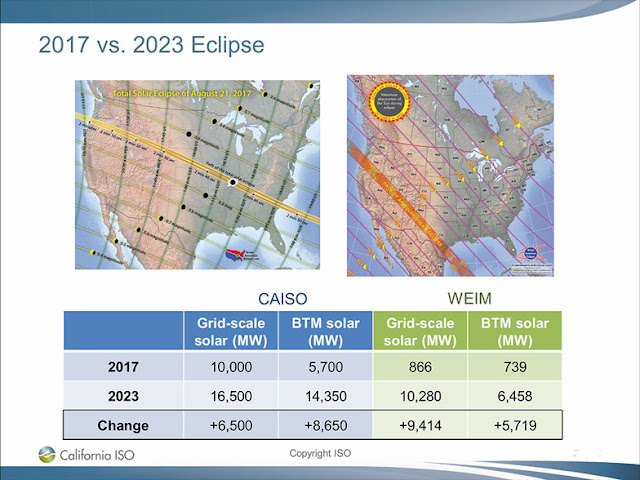Greetings from Palmia Observatory,
Well, many of us are making plans for where we will be to observe the April 2024 total solar eclipse, but the upcoming annular eclipse on October 14 is also on our planning radar. But as astronomers we often forget about another group that is especially interested in eclipses: Electric Utilities who must plan for the loss of solar generated power at that time.
This Resident Astronomer, having worked previously in various aspects of power generation equipment and interconnection to the utility power system, I attended an online webinar on how the utility system coordinators are planning to keep the lights on during the entire eclipse period and will make some summary comments about that.
But first, let me provide some blog references to previous eclipses that we were lucky enough to observe firsthand. For the 2017 total eclipse we travelled to Casper, WY. The 2017 Astrocon was held in Casper in conjunction with viewing the eclipse. Some summary comments from the days before the eclipse are at blog url: August 16, 2017 Blog Post
Some 2017 eclipse photos and details are at blog url: August 23, 2017 Blog Post
Some 2019 eclipse photos from Chile are at blog url: July 3, 2019 Blog Post
Many OCA observers have already elected to travel somewhere else or just stay in OC and get about 70% obscuration for the October 14 eclipse. Resident Astronomer Peggy and I expect to be in southern Utah to observe 95% obscuration, possibly even the annular ring.
But now let's consider how electric utility planning folks are going to respond to the eclipse. The main effect is the loss of solar generated power and even some degradation of wind generated power. The California Independent System Operator (CAISO) sees eclipse impacting California system from 8:00 am to 11:00 am.
 |
| Eclipse Overview (Source: CAISO Webinar on Utility System Preparation) |
It is interesting to look back and see how the utility grid was affected by the 2017 eclipse. In this screenshot we how the eclipse notched out about 6000 MW of solar power production. This lost energy source has to be made up by other power purchases like from standby gas fired turbine generators. In addition to loss of utility scale solar power plants, the load demanded by customers increases because many businesses have what is termed, "Behind the Meter (BTM)" solar arrays. These arrays provide power for the internal parts of the business and just show up as reduced load from the utility billing standpoint. But during an eclipse, this loss of solar power is made up by the businesses buying more power from the utility.
 |
| 2017 Eclipse Effects of state power demand (Source: CAISO Webinar on Utility System Preparation) |
In this screenshot we see different level of impact for the 2017 vs. 2023 eclipse. California has much more solar power installed in 2023 so the impact of the eclipse can be more severe. More of the sun will be obscured during the 2023 annular eclipse also so its impact is higher. The Western Energy Imbalance Market (WEIM) is a wider area covering multiple states. Somewhere in the neighborhood of 30% of connected annual load is provided by renewable energy.
 |
| 2017 vs. 2023 Eclipse Effects (Source: CAISO Webinar on Utility System Preparation) |
For those who have observed a total eclipse you also experience an eerie silence as birds often stop chopping and the ambient temperature gets cooler quite quickly. There is also less wind and the air becomes calmer, but the wind speed reduction can also result in less wind power generation during the eclipse period.
This screenshot shows for expected obscuration of about 70% in OC that there should be minimal interruption of wind power energy. In areas where the obscuration is > 85% then reduction of wind power is to be expected.
 |
| Eclipses affect temperature and wind speed (Source: CAISO Webinar on Utility System Preparation) |
Overall, what the CASIO challenge is to match the reduction in solar power during all portions of the eclipse with increased generation from gas fired turbine generators or energy storage systems. In the last screenshot we see the expected loss of solar power reaches a maximum of 6600 MW. This amount of power must be produced by other sources to keep the volage and frequency of the grid within allowable limits.
A major problem in trying to keep electrical load and electrical generation in balance is the need for the ramp rate, the rate at which external generators can be commanded to change their power output, has to match the loss of solar power ramp rate. The interesting thing about the ramp rates, all dictated by the design of the power plants, is that the ramping down rate is often higher than the ramp up rate. Battery Energy Storage Systems (BESS) can really be helpful here because their ramp rate, both up and down, can be very fast compared to other mechanical generators. The projection is for maximum required ramp up rate is 68 MW/minute, while the maximum required ramp down rate is 105 MW/minute. The challenge for the CAISO is to arrange for the right number of generators that can be brought online in a contractually controlled way at an agreed to price. There might be several cases where some standby generators are contracted to run for just a few hours during the eclipse while they are offline for the rest of the day or week.
 |
| Eclipse Overview (Source: CAISO Webinar on Utility System Preparation) |
So, when I was sort of involved in some of the issues of power system dynamics and energy storage and generation systems, it is much more fun now to just be out enjoying the eclipse, trying to take some good photos, and not go blind, and just experience the obscuration of the sun.
Until next time,

No comments:
Post a Comment